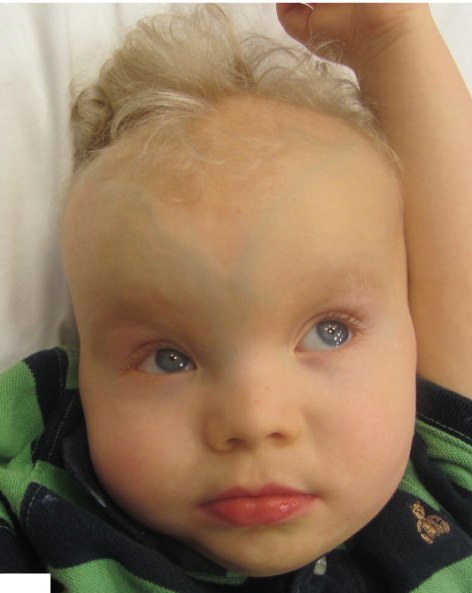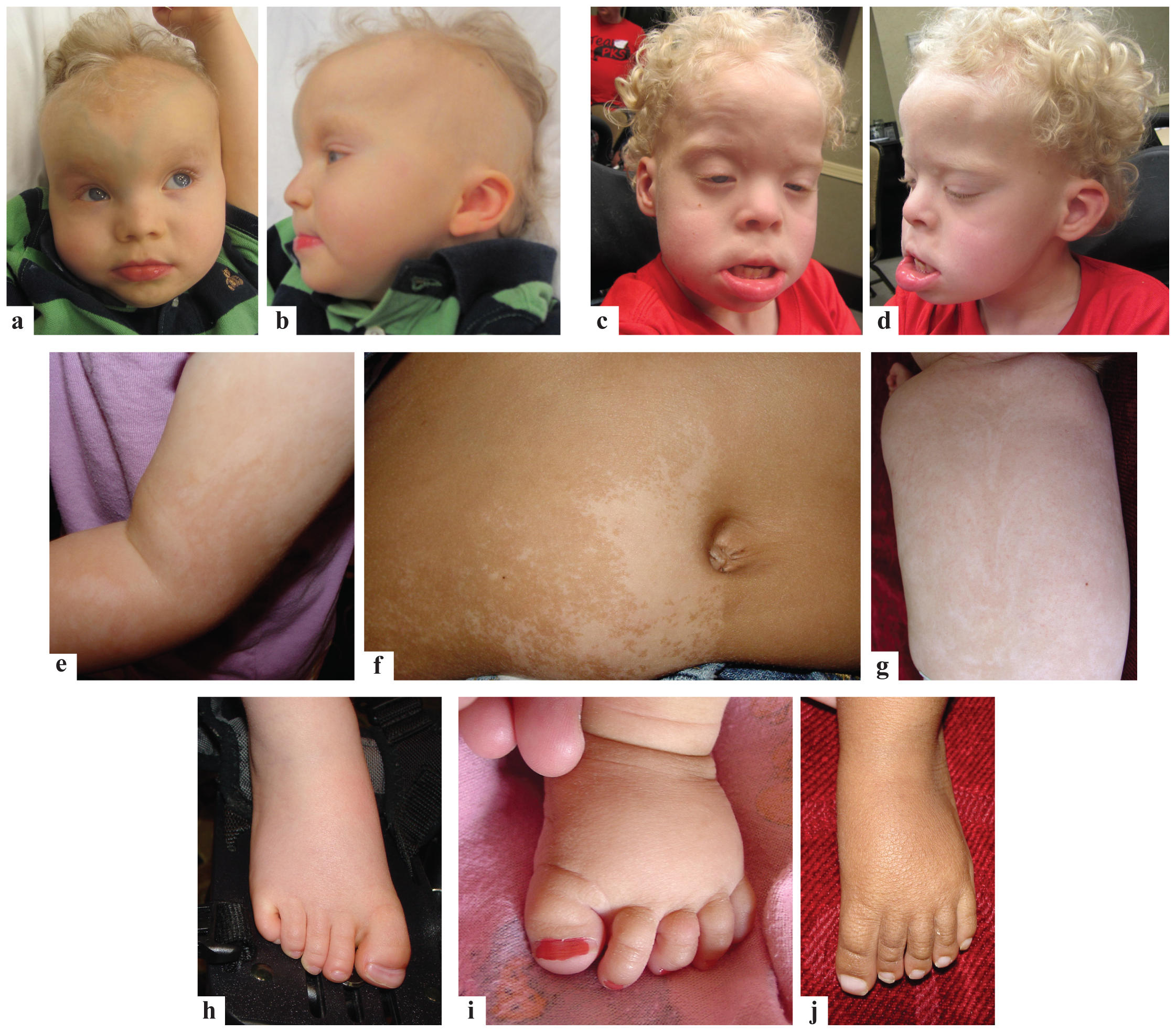Pallister Killian Syndrome (PKS)
Pallister Killian Syndrome (PKS) is a member of a group of conditions called overgrowth syndromes. In general, the overgrowth syndromes are often very different from one another, but they all involve overgrowth of the whole body (such as excessive length and weight at birth) or a part of the body (such as abdominal organs or the tongue). Other members of this group include (but are not limited to) Sotos syndrome, Beckwith-Wiedemann Syndrome (BWS) Proteus syndrome, neurofibromatosis type I (NF1), Weaver syndrome, Simpson-Golabi-Behmel syndrome, Sturge-Weber syndrome, macrocephaly-capillary malformation, and fragile X syndrome. Fragile X syndrome and NF1 are the most common members of this group.
Clinical information
Pallister Killian Syndrome is a very rare disease that causes epileptic seizures, intellectual disabilities, and a variety of problems that exist from birth. The syndrome was first described in 1977, making it a relatively newly described condition (1). Patients with PKS may have mild developmental disabilities, though problems are more often severe. Both cognitive and motor abilities are affected. Many patients cannot walk or care for themselves, are non-verbal, and/or suffer from hearing loss. Infants with PKS may be large at birth, with growth slowing afterward.
Sparse hair or hair loss is a trait commonly seen in young children with PKS. In particular, PKS patients tend to have little or no hair on the sides of their heads above their ears (see photo b below). As children grow older, hair often grows into these areas. Patients with PKS share similar facial characteristics, including the following:
- Macroglossia (an enlarged tongue that may protrude from the mouth)
- Wide-set eyes (hypertelorism; see photo at right)
- Wide mouth with thin upper lip
- Highly arched or cleft palate
- High, rounded forehead
- Broad nasal bridge
- Downslanting eyes
- Low-set ears
- Short neck
A number of other clinical features can help identify PKS. They include the following:
- Developmental delays (cognitive and motor skills)
- Floppiness (low muscle tone; aka hypotonia)
- Delayed speech development or no speech
- Abnormal skin pigmentation (see photos)
- Repetitive behaviors (stereotypy)
- Difficulties with walking
- Feeding difficulties
- Impaired vision
- Hearing loss
- Extra nipples
- Seizures
In addition, many infants with PKS are born with a diaphragmatic hernia, in which there is a hole in the muscle separating the abdomen from the chest cavity (the diaphragm). This hole lets the stomach and intestines to move into the chest. It can be a serious problem because the stomach and intestines can crowd the heart and lungs, which in turn can affect their development.
Some patients with PKS also have a "Pallister lip." This term means that the top of the person's uppler lip is V-shaped. This trait can be seen in the photo of the boy on the right. For a closeup view, click here.
PKS is sometimes called Pallister mosaic aneuploidy syndrome, tetrasomy 12p mosaicism, or Teschler-Nicola/Killian syndrome.
Diagnosis and Testing
PKS is a chromosomal disorder that occurs sporadically (is not inherited). The chromosomal change that causes PKS appears to occur during the formation of eggs or sperm. Currently, there is still no explanation for why this happens. To date, there has been no history of PKS in the families of affected individuals, and the liklihood of having a second child with this syndrome appears to be low.
PKS patients have two extra copies of a part of chromosome number 12. Diagnosis is usually clinical, but can be confirmed by testing cultured
In making a diagnosis, PKS should be distinguished from Fryn's syndrome and trisomy 12p (in which there are 3 copies of part of chromosome 12p instead of 4 in PKS). Fryns and PKS are easily confused, and a skin biopsy may be necessary to distiguish them. For parents wishing to have another child, testing is important. Fryn's syndrome is an autosomal recessive condition, making the chance of having a second affected child high in comparison to PKS.
For accurate results, a skin biopsy or a buccal smear is required. Incorrect testing procedures can lead to false negatives. In particular, investigators should avoid the use of blood samples, as the additional chromosome may not be found in blood cells or may be present in only a low percentage of them (2). In addition,the length of culture time may also affect results, with shorter culture times possibly being preferred (3)
It is important to note that books or papers on PKS published before the early 1990s may be relatively pessimistic in their outlook for patients. For example, older publications may describe them as being unable to walk, talk, or care for themselves. This outlook may have been more negative than it is now because relatively few patients had been identified by that time. In addition, it is also possible that the newness of the disease resulted in more severe cases being identified initially. While the syndrome's effects are often severe, as many as one-third of patients will be able to walk, and as many as a quarter of patients have only mild or moderate intellectual disability (5), with some of that group able to benefit from attendance at a mainstream school (6), likely with help from an aide. IQ in the normal range has been reported, though these individuals may still have learning disabilities and problems with social skills and skills of daily living (7). The number of mildly affected patients may be artificially low due to underdiagnosis in this subgroup.
Prevalence
A recent study tallied 36 PKS patients living in the United Kingdom (7). This figure equates to 0.6 patients per million in the UK, or 1 person with PKS per every 1.7 million people. The same study also calculated birth incidence of PKS during the years 2005-2009 as 5.1 per million (19 cases out of 3,707,352 live births).
References
- 1. Pallister PD et al. (1977). The Pallister mosaic syndrome. Birth Defects Orig Artic Ser: New Syndromes 13(3B):103-110. Citation on PubMed.
- 2. Wilkens A et al. (2012) Novel clinical manifestations in Pallister-Killian syndrome: Comprehensive evaluation of 59 affected individuals and review of previously reported cases. Am J Med Genet A 158A(12):3002-3017. Abstract on PubMed.
- 3. McPherson EW (2005) Pallister-Killian and Fryns syndromes: Nosology. Am J Med Genet Part A 47(2):241-245. Abstract on PubMed.
- 4. Kaur M et al. (2014) Genome-wide expression analysis in fibroblast cell lines from probands with Pallister Killian syndrome. PLoS One 9(10):e108853. doi: 10.1371/journal.pone.0108853 Full text on PubMed.
- 5. Blyth M et al. (2015) Pallister-Killian syndrome: a study of 22 British patients. J Med Genet 52(7):454-464. Abstract on PubMed. Full text on ResearchGate.
- 6. Genevieve D et al. (2003) Mild phenotype in a 15-year-old boy with Pallister-Killian syndrome. Am J Med Genet A 116A(1):90-93. Abstract on PubMed.
- 7. Stalker HJ et al. (2015) High cognitive functioning and behavioral phenotype in Pallister-Killian syndrome. Am J Med Genet A 140(18):1950-1654. Abstract on PubMed. Full text on ResearchGate.


